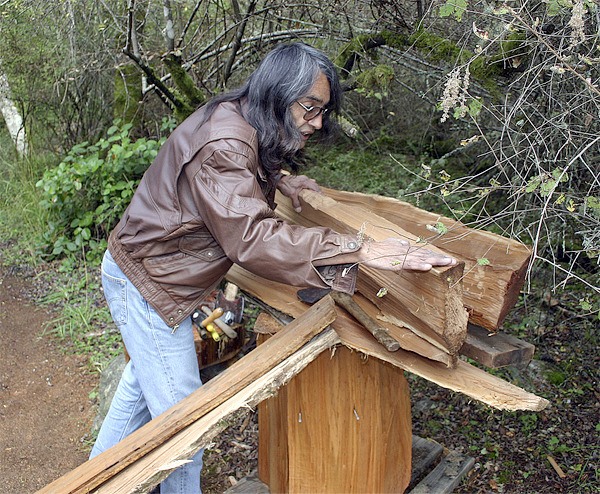An artist would be hard pressed to find a creative place that is closer to nature than Danny Stough’s: At the end of an island road named for an edible mushroom, in a place with an ancient feel, amid standing cedars and cedars that have fallen and become nurse logs, a place where the soil yields surprises (like the spring that was revealed when a neighbor dug a foundation for a house).
It’s in Stough’s DNA to create here, where he can look beyond the moss on the fallen cedar to the paddle waiting to be born from the heartwood of the tree. Or to see, as he puts it, the ocean in a dead standing cedar, a sign that it too holds a paddle inside.
It is here amid the aromatic and sensuous splendor of a cedar forest that Stough carves Northwest Coast Native style paddles making their way into private collections; two paddles are on display in the lobby of the Technology Center on Mullis and Market streets.
Stough, an Alaska Native/Colville artist, has long created this way. He formerly carved jewelry from elk and moose antler, as well as spears and spearheads that were accurate and functional — much like the ones his mother’s people used to catch salmon at Kettle Falls until Grand Coulee Dam was built.
He approaches his work with cedar with the same reciprocal relationship that his mother’s people have had with the land since time immemorial. He considers what he creates a form of prayer.
“It’s a prayer of appreciation for the beauty of the cedar, my attempt to walk in beauty,” he said. “I put a lot of love into my work and send it out into the world. It could be healing for someone. That’s part of the prayer you put into it.”
It’s a cool fall morning and the coffee is brewing and Stough is outside, his tools neatly lined up, and he is penciling the area on a slab of cedar that will become the rough shape of a paddle, to be further refined with a draw knife and a planer and assorted other hand tools.
All of the wood he uses is salvaged from dead or fallen cedars. “I go into the forest – there are fallen cedars in there, some 200 years old and with a foot of moss on them. But in the heartwood, that’s where I get my material. I get my material from the heart of the tree and I put my heart into it. It’s rich in symbolism.
“Each piece of wood says something different. Part of the joy is getting out and finding it … The older the wood, the more the story in the wood. The things it’s seen, it has a history of its own.”
Cedar has long given to the First Peoples of this region. It gave bark fiber for baskets, clothing and fishing nets; planks for houses; wood for canoes that carried families; posts that supported longhouses; boughs for blessing and for brushing off a hunter’s scent.
Stough’s paddles do indeed tell a story. Hold a paddle and feel the smoothness in your hands; you are holding the same kind of paddle the Ancestors used to travel in cedar canoes in the Salish Sea. The paddle may be carved from a piece of wood that as a sapling predates European contact. It’s the kind of paddle used today in the cultural renaissance called the Canoe Journey, in which more than 100 canoes from First Nations throughout the Northwest Coast travel from territory to territory, sharing dances, language and songs at each visit.
Stough usually completes a paddle in about 10 days, working eight hours a day. He likes working with yellow cedar. “It’s like carving a stick of butter. The grain is tighter, but it’s easier to carve.”
Stough is now carving a Kokanee paddle, which is more suitable for racing canoes. “It’s designed to cut through water like a blade,” he said.
Marc Forlenza of Friday Harbor, who with his wife Denise collects Northwest Coast Native art, said Stough’s paddles “have a real natural beauty to them. He has a natural feel for wood.”
Barbara Marrett, manager of Arctic Raven Gallery in Friday Harbor, said, “He does it all by hand. He doesn’t use any power tools to even get the basic shape. He’s got a really good eye. He’s seems so inspired by doing it, by making those paddles and making them beautiful.”
Stough has other outlets for his creativity. He is a landscaper. And he had a role in “Apart from That,” a movie produced by ForeignAmerica Pictures in 2006. The movie is about a Native road striper, a student beautician, a Vietnamese banker, his adopted son and an elderly exhibitionist who attempt to find their footing in a world of miscommunication and unmet expectations. Cast members included Kathleen McNearney, who went on to TV’s “The Young and the Restless.”
Variety called the film “outstanding if demanding work … Each story strand carries added meaning, while visuals provide glimpses connecting these disparate and lonely folk.”
— For information about ordering a paddle, contact Stough through Forlenza, 472-1644.



